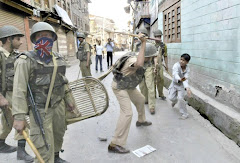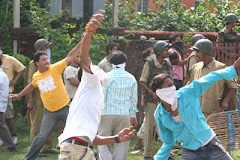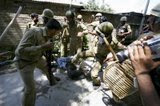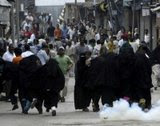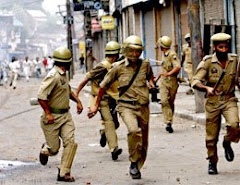When 40 persons fell to the bullets of ruthless forces at Bijbehara
Courtesy: Daily Rising Kashmir dt October 22nd, 2009 by Zahir-ud-DinSrinagar, Oct 21: On October 22, 1993, the Indian border guards (BSF men) deployed in Bijbehara on Srinagar-Jammu highway fired on peaceful and unarmed protestors, who had taken to roads to protest against the siege of Hazratbal shrine. At least 40 persons were killed in the BSF firing. It was Friday and after finishing the congregational prayers around 15000 people assembled in the courtyard of Jamia Masjid, Bijbehara to register their protest against the siege of Hazratbal shrine by army. A procession was taken out, which marched through various streets. As the processionsts, who were demanding end to siege reached the Goriwan locality, they were intercepted by BSF men, who blocked the roads. Without any provocation, the BSF men fired indiscriminately on the unarmed protestors, killing at least 37 persons on spot and injuring more than 200 others. The firing continued for nearly 10 minutes and troops targeted the crowd and those, who lay injured on the ground.No ambulances or medical staff was allowed access to the injured persons although hospital was only few yards away from the site of the massacre. According to doctors posted in the hospital, most of the people could have been saved had the ambulances and medical aid been allowed to reach the victims. Later, when people managed to shift some of the injured to hospital, the BSF men even fired on them inside the hospital complex, killing and injuring more people.Police later registered an FIR No 90/93 under section 302 and 307 RPC. However, no arrest was effected.The official version claimed that the Bijbehara killings were consequence of militant firing on a road-opening party of troops. This theory of militant attack was readily accepted by two premier Indian news agencies, which falsely carried news stories that many of the dead were militants and involved in various killings and attacks on the paramilitary forces. These false news reports were carried and given prominent space by all the Indian newspapers and other media outlets.Soon after the news of the massacre went out, Indian government barred independent local and international media persons from entering the town. On October 23, 1993 when large number of local and foreign media persons converged on the town, the army used violence and shot in air to stop them from visiting the old side of the town and the newly dug ‘martyrs graveyard’. The army men even attacked mourners, who were burying the dead in the graveyard.
The Inquiry report, vide number EN/BFC/93/23-24, prepared by the Inquiry Magistrate and submitted to the government on 13th November, concluded that firing on the procession was absolutely unprovoked and the claim made by the security forces that they fired in self defence after militant firing is baseless and concocted.
The inquiry report further stated that the security personnel have committed offence out of vengeance and their barbarous act was deliberate and well planned. The report indicted Deputy Commandant of BSF JK Radola for tacit approval given by him to indiscriminate and un-provoked firing.After sixteen years, the victims are still awaiting justice.
Wednesday, October 21, 2009
Tuesday, October 20, 2009
Rawathpora remembers Rashid on second anniversary

Courtesy: Daily Greater Kashmir dated Oct., 20th, 2009 by SHAHID RAFIQ
Rawathpora (Kupwara), Oct 19: Rawathpora village in this frontier district Monday remembered Abdul Rashid Mir, 25, on his second death anniversary. On October 19, 2007 Mir was allegedly shot dead by a road opening party of army led by a subedar of 46 AD, after he had several times resisted the moves of army to taunt his female colleagues. People including teachers and his friends went to the graveyard where Mir was buried and offered fateh. They termed Mir a martyr of Kashmir struggle who sacrificed his life to save the honour and chastity of his two female colleagues.
“Rashid is a role model for every Kashmiri youth as he sacrificed his life to protect the dignity and chastity of his sisters” said Jawahira, his sister.
Mir was a first M. Sc Physics of the area and was working as a teacher in Government Middle School Marsary. Locals said that Mir had objected many a times to the absence comments passed by a subedar and other soldiers at his female colleagues. “He always used to accompany female colleagues so that army men won’t tease them on to their way to school and back home,” they said.
“But on October 19, 2007 Mir had to pay a price for it as he was shot dead by the troopers. On the fateful day Mir was returning alone after his duties and when he reached near the post he was shot dead. Army later claimed that the teacher was killed in accidental fire from a soldier’s rifle while being searched,” they added.
An FIR No-147/07,U/s 302 stands registered in police station Kralpora against Army’s 46 AD (Chowkibal based battalion) for killing the teacher. “Two years have passed but police is yet to charge sheet the accused. The killers of my son are roaming freely. Before my death I want to see the troopers responsible for my son’s cold blooded murder behind the bars,” demanded Rashid’s mother Zareefa. A middle rung police officer on the conditions of anonymity told Greater Kashmir that ‘case was not moving ahead as Army authorities were not cooperating with investigation team.’ “Despite several representations Army wasn’t ready to hand over duty log book of Oct 19, 2007 which contains the details of the troopers on road opening duty and name of their commander. We have recorded the statements of more than 22 eye-witnesses,” he added.
Saturday, October 3, 2009
On Oct. 1, Indian troopers massacred 22 civilians at Handwara
Handwara Remembers ’90 Massacre
Courtesy: Daily Greater Kashmir dt. October 1st, 2009 by UMER MAQBOOL DARHandwara, Sept 30: Twenty years on, the memories of Handwara massacre are still fresh in the minds of people and continue to haunt the survivors in this north Kashmir town. On October 1 in 1990, troopers of 13 Kumaon regiment and personnel of Border Security Force killed 22 civilians in cold blood and set the town ablaze, to avenge the killing of a BSF trooper by militants. Locals said it was a sunny day and people were busy in daily chores. A militant named Shabaz shot dead a BSF trooper in the market. “The BSF men in retaliation fired upon him, killing him on the spot,” said Nazir Ahmed, an eyewitness. “The soldiers of 13 Kumaon traveling in a convoy through the town went berserk and showered bullets on unarmed civilians and torched crops, shops and houses without any provocation,” he added. “The naked dance of death and destruction continued for more than an hour,” said Javid Ahmed, a local resident. The mere thought of that fateful day still sends shivers down the spine of the survivors. “When troopers tried to roast my brother alive, my mother resisted their attempts and tried to save him from their clutches. But they dragged her and pierced her body with bullets. After killing my mother they shot dead my brother also,” said Bashir Ahmed. “The troopers reduced the town to ashes by torching shops and houses indiscriminately,” he said. After the incident, police registered a case and assured the residents that erring troopers would be punished. A First Information Report was also registered against troopers of 13 Kumaon regiment. “There was no headway after the case was registered. We are waiting for the day when the killers would be punished. The government should reopen the case to hang the killers who snatched our beloved from us,” said a local resident.
Courtesy: Daily Greater Kashmir dt. October 1st, 2009 by UMER MAQBOOL DARHandwara, Sept 30: Twenty years on, the memories of Handwara massacre are still fresh in the minds of people and continue to haunt the survivors in this north Kashmir town. On October 1 in 1990, troopers of 13 Kumaon regiment and personnel of Border Security Force killed 22 civilians in cold blood and set the town ablaze, to avenge the killing of a BSF trooper by militants. Locals said it was a sunny day and people were busy in daily chores. A militant named Shabaz shot dead a BSF trooper in the market. “The BSF men in retaliation fired upon him, killing him on the spot,” said Nazir Ahmed, an eyewitness. “The soldiers of 13 Kumaon traveling in a convoy through the town went berserk and showered bullets on unarmed civilians and torched crops, shops and houses without any provocation,” he added. “The naked dance of death and destruction continued for more than an hour,” said Javid Ahmed, a local resident. The mere thought of that fateful day still sends shivers down the spine of the survivors. “When troopers tried to roast my brother alive, my mother resisted their attempts and tried to save him from their clutches. But they dragged her and pierced her body with bullets. After killing my mother they shot dead my brother also,” said Bashir Ahmed. “The troopers reduced the town to ashes by torching shops and houses indiscriminately,” he said. After the incident, police registered a case and assured the residents that erring troopers would be punished. A First Information Report was also registered against troopers of 13 Kumaon regiment. “There was no headway after the case was registered. We are waiting for the day when the killers would be punished. The government should reopen the case to hang the killers who snatched our beloved from us,” said a local resident.
Subscribe to:
Comments (Atom)














